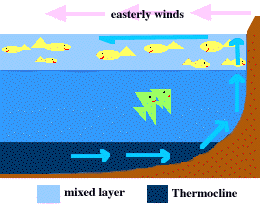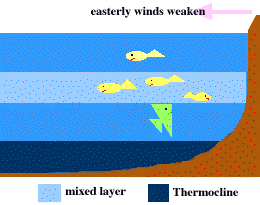The coast of Peru is one of five major fishing grounds in the world (along with the coastal waters of California, Namibia, Mauritania, and Somalia). The abundance of fish is supported by the upwelling of nutrient rich waters from deeper levels (below the thermocline).
 |
During non-El Niño years, the southeast trade winds, drag surface water westward away from shore. As surface water moves away, upwelling brings up colder waters from depths of 40-80 meters or more. This deep sea water is rich in nutrients which can sustain large fish populations. |
 |
During an El Niño event, the southeast
trade winds weaken
and so does the amount upwelling in the eastern
Pacific.
The deeper thermocline means that any upwelling that does occur is unable to tap into the rich nutrients found in deeper waters. Consequently, warm nutrient-poor water predominates the region and a decrease in the fish population is observed. |
A reduction of the fish population reduces the amount of fishmeal produced and exported (by local industry) to other countries for feeding poultry and livestock. If the world's fishmeal supply decreases, more expensive alternative feed sources must be used, resulting in an increase in poultry prices worldwide.

impacts on weather |
|

prediction |